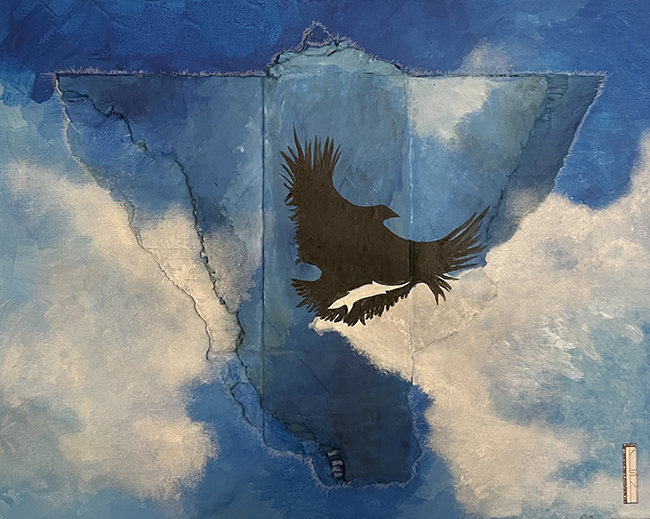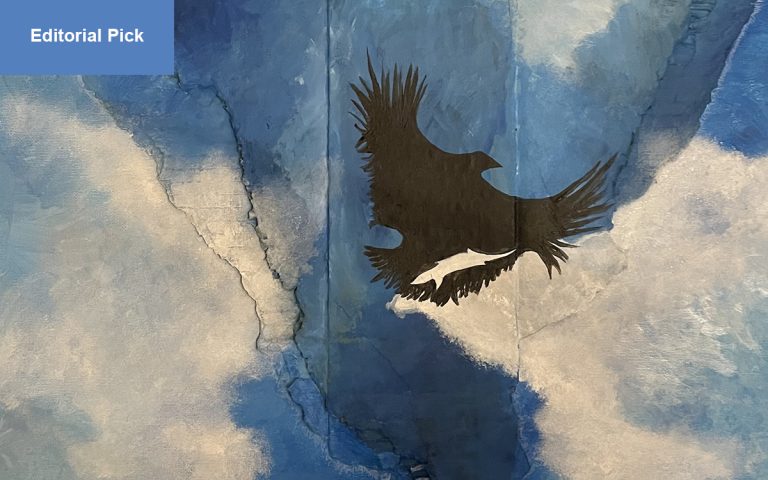Deborah K. Tash was born in 1949 and grew up in California’s Bay Area. From an early age, she saw no need to separate poetry from painting. Words and images carried the same weight for her, each a way of telling story. She calls herself a Mestiza, rooted in the Mexican heritage of her mother and the Celtic lineage of her father. This mixture is not just a genealogical fact—it is the lens through which she sees the world. For Tash, culture and ancestry are more than memory. They are ongoing, living presences. Her work is a place where they converge, where earth, sky, myth, and human experience come together without division. What results are paintings that feel layered and ceremonial, like offerings made to both the past and the present. Tash doesn’t choose between her worlds—she works to hold them all, side by side, at once.

Totem Series / Raven Sky
The painting Raven Sky, part of Tash’s Totem Series, carries the quiet authority of a ritual object. Built from humble material—a piece of cardboard shaped like a shaman’s robe—it has the feel of something handmade and sacred. Tash collages this cardboard form onto canvas, then surrounds it with paint. A sky-blue background opens wide across the surface, populated by soft, white clouds. In the foreground, she positions an abstract raven, dark and angular, flying through that expanse.
At first glance, the piece seems simple: a sky, a robe, a bird. But it’s the combination that makes it resonate. The cardboard robe isn’t just a shape—it stands in as a totemic garment, something a shaman might wear in ceremony, designed to cross the threshold between the human and the spirit world. The raven, too, is not literal. It’s abstracted, made of form and gesture rather than feathers. It doesn’t perch or rest; it cuts through the sky like an ally. In Indigenous traditions of the Americas and Celtic myth alike, the raven often takes the role of messenger, trickster, or guide. Tash brings those meanings into her canvas, leaving space for the viewer to feel the bird’s presence without being told exactly what it signifies.
There is also the choice of cardboard, a material often dismissed as temporary, disposable. By shaping it into the form of a robe and anchoring it on canvas, Tash elevates it into something ceremonial. The act is quiet but insistent: what is overlooked can carry power. Cardboard becomes more than packaging—it becomes a vessel for memory and vision. This mirrors her own identity as a Mestiza, someone who holds together traditions often overlooked or split apart by history.
The blue sky background is another layer of meaning. It’s painted with calmness, not storm. This choice makes the raven’s flight less ominous and more companionable. The bird is not here as a harbinger of doom; it’s an ally, a guide moving across a sky that invites openness and possibility. Clouds drift in white softness, giving a sense of time passing, of air and light in motion. Against this expanse, the raven becomes not just a solitary creature but a connector, carrying the weight of ceremony across the open field of sky.
Raven Sky also belongs to Tash’s broader Totem Series, where she consistently works with archetypes, ritual garments, and symbols that bridge human experience with nature and myth. In this sense, the piece is not isolated but part of a continuum. Each work in the series speaks to how objects—robes, birds, totems—can serve as mediators between the everyday and the sacred. The cardboard robe is central here, both ordinary and ceremonial. It suggests protection, transformation, and the possibility of stepping into another role or identity.
Looking at the work, one doesn’t need to know all the symbolic traditions it references. The visual elements do the work. The dark bird cutting across bright sky, the robe-shaped form against clouds—these are images that settle into the body as much as the mind. They suggest journey, transformation, and presence. Tash’s skill is not in explaining these ideas but in holding them open. She sets up the stage, gives the symbols their place, and then lets the viewer step in to find their own resonance.
In the end, Raven Sky is less about a single narrative and more about balance—between earth and sky, human and spirit, ancestry and present life. The raven does not belong to one world but moves through all of them. The robe, though cut from something as unassuming as cardboard, carries the imprint of ceremony. Together they make the canvas into a threshold, a place where boundaries blur and stories take flight.

